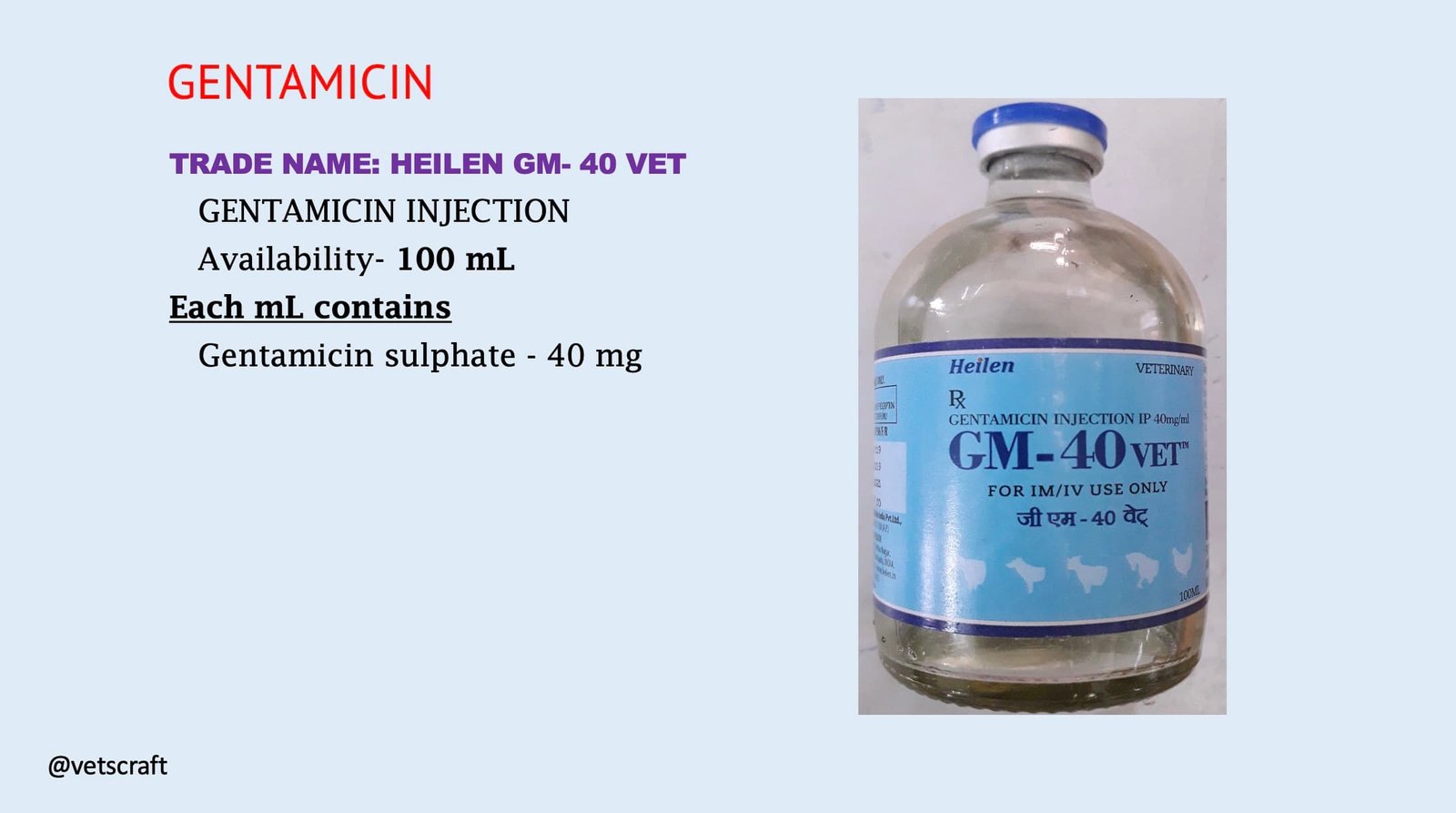TABLE OF CONTENTS
Gentamicin
Gentamicin is a aminoglycoside antibiotic used for animals and humans. it is a bactericidal broad spectrum antibiotic. Gentamicin is naturally produced by the Micromonospora purpurea bacteria.
Group
Gentamicin is grouped in Antibiotics (Aminoglycosides).
Mechanism of Action
Gentamicin acts by inhibiting bacterial protein synthesis via binding to the 30S ribosome. Through this action, it causes a misreading of the genetic code and inhibits bacterial protein synthesis.
The majority of gram-negative bacteria, especially Enterobacteriaceae, are included in the gentamicin spectrum of activity. Against streptococci and anaerobic bacteria, it is not very effective. Although it affects Staphylococcus spp., it is not the treatment of choice for these bacteria.
Aminoglycosides (Gentamicin, Amikacin, etc.) are used with beta-lactam antibiotics (Penicillins, Amoxicillin, Ampicillin, Cephalosporins, etc.) because they broaden the spectrum of activity.
Dose Rates
Dose rate of Gentamicin is given below-
- Dogs and Cats: 5 to 10 mg/kg body weight q24hrs SQ, IM and IV
- Cattle: 2-5 mg/kg body weight q24hrs SQ, IM and IV
- Sheep and Goats: 5 mg/kg body weight q24hrs SQ, IM and IV
- Horse: 5 mg/kg body weight q24hrs SQ, IM and IV
- Pigs: 10-15 mg/kg body weight q24hrs SQ, IM and IV
- Birds: 2-5 mg/kg body weight q24hrs SQ, IM and IV
- Elephant: 4-5 mg/kg body weight q24hrs SQ, IM and IV
Gentamicin is used by the IM, SQ, and IV routes. It is not absorbed after oral administration (PO) in animals. Gentamicin comes in ointment or cream form to be applied to the skin and in eye drop form to be applied to the eyes.
Indications
- Respiratory infections
- Mastitis
- Metritis
- Septicaemia
- Wound infections
- Bloodstream infections
- Urinary Bladder infections
- Infections of the skin and ear
- Colibacillosis
- Peritonitis
Contraindications
Gentamicin should not be given to animals with impaired renal function, renal insufficiency, kidney disease, or renal failure.
Interactions
- Increased ototoxicity and nephrotoxicity with diuretics such as Frusemide.
- Mixing with other antibiotics may cause the inactivation of Gentamicin injections.
Adverse effects
- Nephrotoxicity, ototoxicity, and vestibulotoxicity are the main issues with aminoglycoside antibiotics.
Toxicity
Excessive doses or unwanted ingestion of gentamicin may cause nephrotoxicity, ototoxicity, and vestibulotoxicity in animals. Cessation of the use of gentamicin and substituting it for another non-nephrotoxic antibiotic in cases of toxicity is the treatment.
Preparations
Gentamicin comes in injection, tablet, ointment, or cream form. Tablet form is very rarely used in animals as it is rarely absorbed.
Gentamicin sulphate is seen in injection forms; here are some preparations:
- Inj. GM-40 Vet (100ml vial with 40mg/mL concentration)
- Inj. Gentamor-Vet (30ml and 100ml vial with 40mg/mL concentration)
- Inj. Mycin Vet (100ml vial with 40mg/mL concentration)
- Inj. E-Gmicin Vet (100ml vial with 40mg/mL concentration)
- Inj. GentaZap (100ml vial with 40mg/mL concentration)
- Inj. Genacyn LA (100ml vial with 40mg/mL concentration)
- Inj. Genmust (100ml vial with 20mg/mL concentration)
- Inj. Mactogen (100ml vial with 40mg/mL concentration)
- Inj. Vetamicin (100ml vial with 40mg/mL concentration)
- Inj. Anmycin (100ml vial with 40mg/mL concentration)
- Inj. Gentoxy (100ml vial with 40mg/mL concentration)
- Inj. Theramycin Vet (100ml vial with 40mg/mL concentration)
Gentamicin sulphate is seen in ointment/cream forms; here are some preparations:
- Oint. Gentapar (0.1%w/w Gentamicin Sulpahte)
- Oint. GentaCare (0.3%w/w Gentamicin Sulpahte)
Gentamicin sulphate is seen in ointment/cream forms with some other drugs to increase activity; here are some preparations:
- Oint. Betamil GM (Betamethasone, Gentamicin and Miconazole)
- Oint. Clobetamil G (Clobetasol Propionate & Gentamicin)
- Oint. Clop-G (Clobetasol Propionate & Gentamicin Cream)
- Oint. Betagel-G (Betamethasone And Gentamicin)
- Oint. Dermi 5 (Clobetasol, Gentamicin, Clotrimazole and Clioquinol)
- Oint. Clobenate GM (Clobetasol Propionate, Gentamicin Sulphate, Miconazole Nitrate and Clotrimazole)
More about Gentamicin for animals

Information provided here may be subject to inaccuracies. Please consult a reputable textbook for verification before use. We welcome your feedback and suggestions for improvement via email at hello@vetscraft.com

